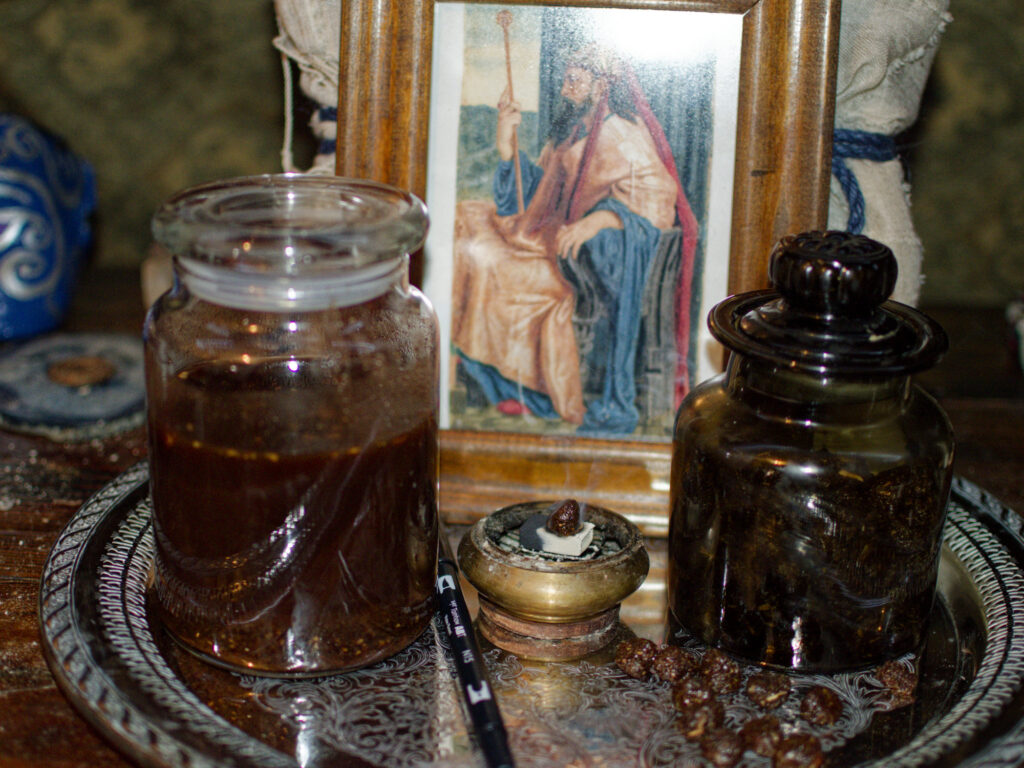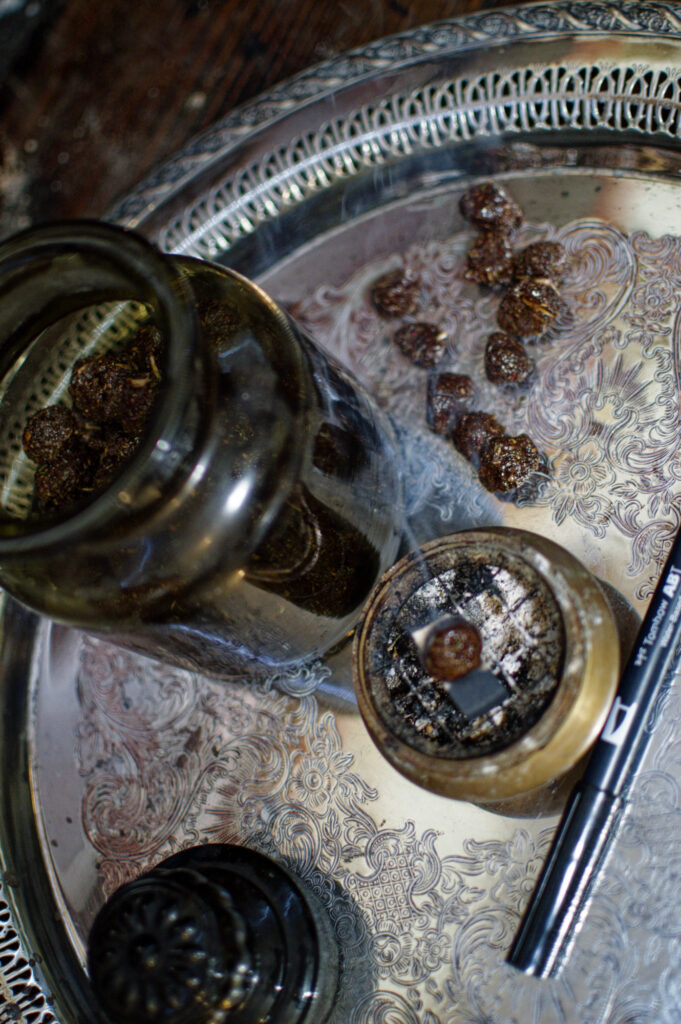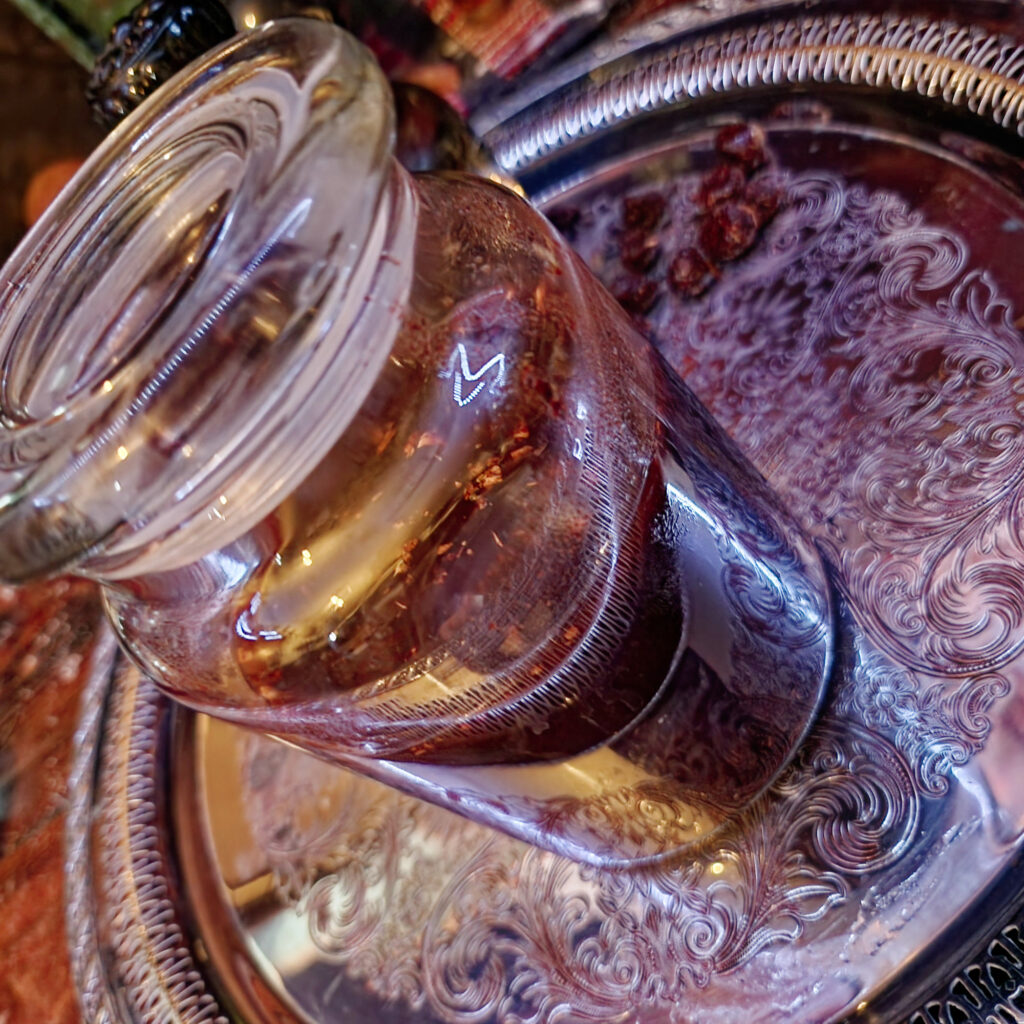
At the beginning of May, I acquired Sara Mastros’ book Sorcery of Solomon: A Guide to the 44 Planetary Pentacles of the Magician King. Shortly thereafter, I signed up for the “companion” course (scare quotes because the book grew out of the course, not the other way around, and contains a great deal of information that couldn’t be fit into the book) and began accumulating the materials for the work.
The book and the course are not, in fact, the same: the Venn diagram of the information and techniques they contain is near circular, but not quite. Broadly speaking, the class just has more: more background, more details, more exemplars, plus (obviously) direct student-teacher interaction and all the benefits of working with a group. But, because there is only one of me and I am not quite crazy enough to double up all the work (some of which literally can’t be done twice and the rest of which would result in two books of pentacles, which … might be of use as a long-term thing, but which would be absurd to do I am working them simultaneously), I will treat them as if they were, in fact, one and the same.
For reference, the format of the class goes like this: Mastros hosts monthly online meetings where she goes over each of the lessons. The first lesson is history and context and making contact with the spirit of Solomon. The second builds on the first and culminates in the construction of your own personal book of pentacles, from which you will make and empower the pentacles you that will actually use. Seven lessons follow, each focusing on the pentacles attributed a particular planet, starting with the Moon and going up the line to Saturn. Then the class culminates in two lessons synthesizing and building on what you’ve learned in the first nine. Then the cycle repeats. When you join the class, you’re given access to the recorded meetings and their slideshows/notes; the expectation is that you’ll work the back catalog at your own pace, attending classes and discussion groups as they come. Students are also strongly encouraged to find a study / accountability buddy in the class to help keep each other on track with the year-long course, and to keep each other honest and on the rails. The book is structured similarly, but not identically.
I joined in May of 2024, just in time to miss Lesson Nine – Saturn. The next cycle will start in September or (more likely) October, depending on how some things shake for Mastros here in meatspace.
Unlike my Hekataeon series, I don’t intend to break this series into dual posts, with one focusing on the material requirements and one on my experiences. This is because Mastros’ class and book are both better organized and more clearly written than the Hekataeon, and do not require that degree of third-party roadmapping. (Sorry Jack.)
Gathering Materials
I have had to take my time gathering all the materials. Between poverty, having my car out of commission for almost three weeks, and trying to source things locally and used as much as possible, it’s been almost six weeks to gather everything I need to wind up this work. I was actually a bit stressed about that for the first couple of weeks, afraid that I’d embarrass myself in front of the class because I wasn’t ready to jump into everything head first.
Finding a book was more challenge than it should have been: I had a particular style of sketchbook that I wanted but wasn’t able to find in my local art stores at a price that I was willing and able to pay. I was able to find something close enough, though, and that I think I’ll be pleased with. It’s not as large as Mastros’ exemplar – only 8.5×11, not 11×14 – but I think that will be large enough for everything that I’m likely to actually do with this book. I was able to find a tasseled white scarf at a local thrift store, and I had some leftover blue cord from another project that turned out to be the exactly correct size to bind the book.
As a professional artist, I have a variety of compasses, protractors, and straightedges to choose from. I was going to use this project as an excuse to buy a better compass, but have not yet found one to my taste in my budget. I have, for the moment, set a protractor and straight edge aside to live with the book. My quest for a swank compass will continue.
Finding an icon was both more and less complicated. As a small business owner (and, honestly, as someone who just hasn’t kept up with the times), I actually own a decent color printer. So, rather than purchasing an icon from an Etsy dealer or Orthodox supply store, I found an image, printed it, myself, and cannibalized one of the many thriftstore picture frames I picked up while thinking I was going to sell prints of my photography. I now keep the framed icon with my veiled and bound Book.

I chose this particular image of Solomon because I thought he looked handsome and majestic in it, the magician king at the height of his power. I also deliberately chose an image in the public domain: https://www.nga.gov/collection/art-object-page.76152.html
Then I turned to sourcing materia for the oil and incense. Most of the ingredients are things I either had on hand or needed to restock, anyway, though some of it was a little pricey: the ceylon cinnamon and the cannabis, specifically. I was prepared to start with just frankincense instead of the full Solomonic incense, but things ended up coming together for me to blend and consecrate both oil and incense at the Full Moon / Summer Solstice combination.
The recipes for the oil and incense (which are available in the free-first-lesson-powerpoint [insert link here]) are given in parts rather than specific units. I can see the advantages of that, but also it’s given me a bit of an autistic fit. Ultimately, I chose to measure out the oil and associated materia by weight, and the incense by volume.
Regarding the oil, that may have been the wrong decision. Either I mis-measured something, or botched my math somewhere, because I my initial results came out as absolute used-coffee-grounds sludge. Getting a consistency that I liked ended up tripling the oil, and creating a supply that will probably last me a lifetime even if I’m extra generous with my friends.
The incense, however, turned out fantastic. It was my first time making incense lumps rather than just powder, but other than hating how the sticky honey felt on my hands (autism things), it came together almost exactly as planned. That “almost” is the fact that I chose the size of my “parts” poorly, and ended up with another lifetime supply when that wasn’t really called for.
For those planning to take the course themselves, my advise is this: when choosing your base measurement, think about what’s going to look like fully assembled.



Hacking the Current
I began, as I said, by reading the book. Once I had access to the archived class videos, I immediately binged them, as well. Inevitably, especially on my first pass, not every lesson got my undivided attention. But, each lesson begins with a prayer and a chant invoking Solomon as patron of the work. So, once I’d acquired the sketchbook, veil, and cord, and once I’d chosen and framed my Solomon icon, I made it my habit to sit down with my book and icon, light incense and a candle, and join the chant.
After a few rounds of that – one day, in particular, when I made it through three lessons in a day, each with its own new round of offerings – I could feel the energetic current of the class. I almost want to say that joining asynchronously, as I did, made it easier to feel the current at large, because I could pause the video, light my offerings, and then unpause and focus on the chanting.
Having found the current, I reached out and … joined it, adding my own voice to the chanting, and drawing power from the chanting down into my icon and book.
I did something similar, way back in the day (2014), when I was joining Seven Spheres in Seven Days experiments that preceded the Seven Spheres book.
Courting Solomon and the Mighty Dead
Regular readers may recall that I am deeply uncomfortable with ancestor work of any kind. I am only marginally less uncomfortable with saints and the Mighty Dead. But one of the reasons I took this class was to push my own boundaries, so here we are.
I began courting Solomon as a patron in the work as I described above, making offerings at the beginning of each (recorded) class. I also began including Solomon (and the nascent spirit of the Book, awaiting consecration and awakening) in my morning rituals, which revolve offering incense, a candle, and a cup of coffee to all the gods, powers, patrons, allies, friends, familiar spirits, and anyone else who lives on the altars of my house, in the pages of my sacred books, or comes when I call and aids me in my work.
That bore fruit more quickly than I anticipated. I made direct contact with the spirit of Solomon in the first week of June. He seemed a little confused at where he’d manifested, but also curious, which … same, bruh. In subsequent contact, in which I asked him if there were any particular stipulations that I needed to observe as I approached this work, I have been told: A) Not to contact him on the Sabbath except for Saturnian work; and, B) to approach the work with an open heart.
Obviously, I will continue to develop that relationship. Swift success has saved me from the need of making another infuriating attempt at dream incubation (Mastros’ recommended method for spirit communication when they don’t just show up for morning coffee), but not from some of the specific conversations needed before beginning the work.
I have not yet begun courting the Solomonic lineage of teachers, translators, and preservers. This isn’t a major part of the work, but it is something that Mastros recommends, at least at the beginning. I am, as is probably well know to all at this point, deeply uncomfortable with ancestor work, and for whatever reason approaching the lineage as a whole is psychologically more difficult for me than approaching Solomon, himself.
On the Treatment of Holy Names
The study and creation of Solomonic pentacles brings a new logistical problem to my practice: the disposal of pages on which Hebrew holy names have been written. My usual witchcraft, chaos magick, and neo-hellenistic practices have no particular taboos about written names; some white middle-class fuckery about preserving books, sure, but that’s not quite the same. My general practice is to burn failed experiments, expired materials, and even the remains of successful magic whose need has run its course.
The Hebrew religious, magical, and literary traditions from which the pentacles come, however, have some very strict rules about the creation, use, and destruction of such names – specifically (assuming I’m understanding correctly), any page on which such a name is written becomes a person, and must be mourned and buried accordingly. Synagogues, I have learned, have special repositories for such things. It’s not exactly my theology, but I can wrap my head around the need to see my Book and any consecrated and activated pentacles I have made consigned to such an end. I can come up with ways to make that work.
But I’m having a little more trouble trying to decide what to do with practice pages and dry runs. After reviewing that section in the course material (video Lesson Two: Planets and Craft), I believe that I will collect my practice pages carefully and burn them ceremonially at Samhain, and use that sacred ash to make sacred salt and/or ink. But I think I’m also going to talk to other folks in my class and see what compromises and solutions they’ve come up with.
Preparing For the Next Stage
With the above work done, I am ready to move on to the next phase: consecrating the book as a magical companion and familiar, and inscribing the Great Seal of Solomon from which all the subsequent seals will draw (at least a portion of) their power.
I’ve started assembling all the instructions from the book and videos into a coherent-to-me ritual. My study buddy and I have planned out the dates we intend to consecrate our books, and empower our Great Seals. Mostly, we’re waiting on the waxing moon.
I’m excited to take the next steps in this new (to me) magical adventure.
This is the first post in a series. Click here for the second post.
